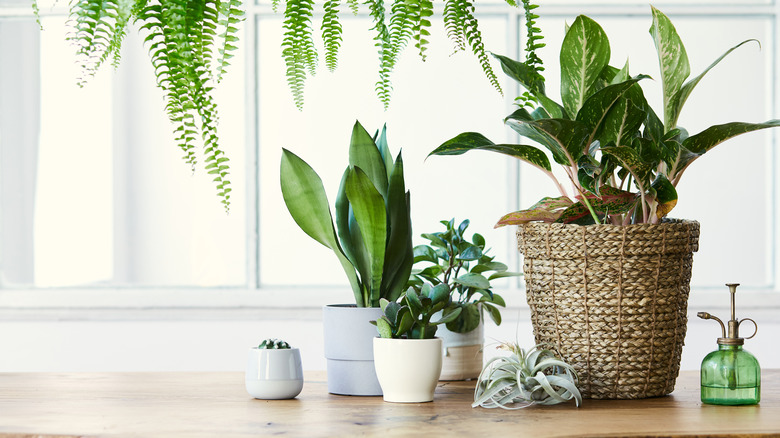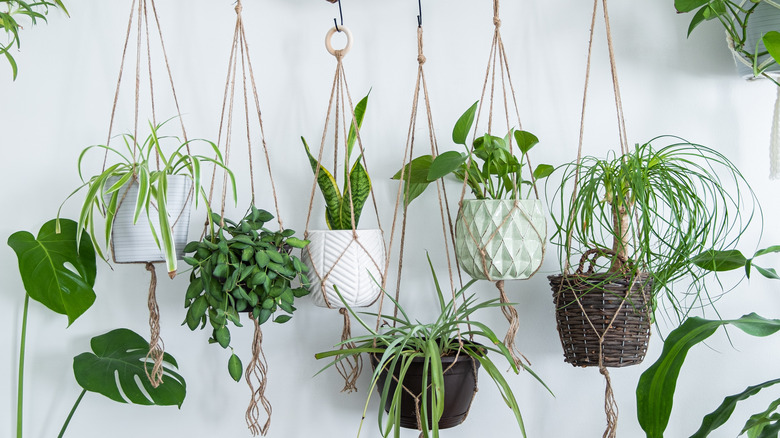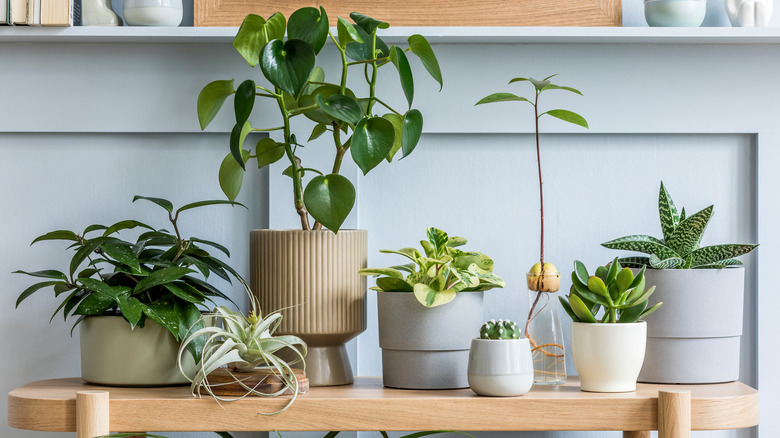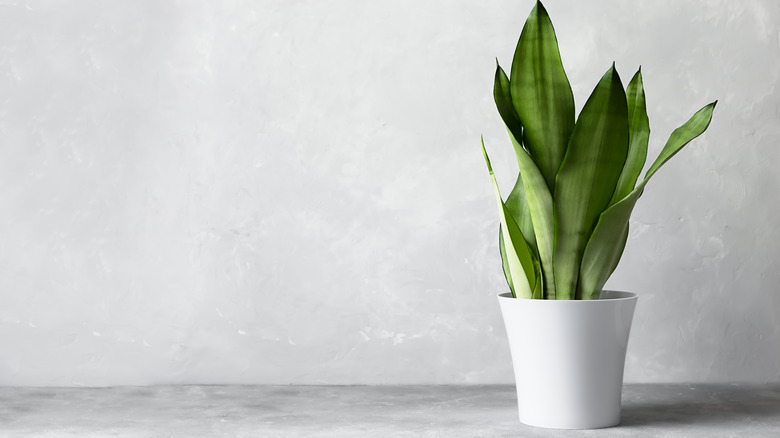If Your New Year's Resolution Is To Keep Your Plants Alive, Read This
Who doesn't love a living room full of thriving, lush potted plants? We absolutely adore the look of a green, vibrant home, whether that involves cute, colorful cacti in tiny pots lining a bookshelf, or verdant, leafy plants like bamboo palms and monsteras around your dining room.
While we also love picking up bouquets of flowers at our local supermarket and filling glass vases to the brim with them, the practice is very different from actually keeping a living, breathing plant in your home. Sure, we'll take a gorgeous vase full of a dozen ruby red roses, marigold tulips, or ballerina pink peonies any day with absolutely no complaints. Fresh flowers are some of the best things there are in life, both from how much they can brighten up a room and make it smell absolutely amazing as well (better than any air freshener in our book!). That being said, flowers die in just around a week, making it an expensive, time-consuming, sometimes finicky pastime. That's where keeping an array of potted plants comes in — aka one of the most rewarding hobbies ever.
You might have shied away from keeping potted plants in the past, possibly from a negative experience involving your poor plant dying much too soon or simply the notion that they involve tons of time and energy. If you've finally decided on the New Year's resolution to keep plants at home — and keep them alive — we've rounded up all the best tips and tricks to get you going.
The most important tip? It's all about sunlight
One of the most important tips to remember when trying to successfully keep your indoor potted plants alive is remembering the power of natural sunlight. If your plants are usually kept in a slightly dim corner of your living room, consider moving them to a place where they get hit by direct sun. As explained by All Green, making sure your plants get an ample dose of sunlight is crucial to making sure they thrive for a long time. If access to lots of light is impossible, go for a plant that thrives with less sunlight, like leafy snake plants (via ProFlowers).
Another tip when it comes to sunlight is "walking" your plants outside for a little. As per Purple Care, plants should go on a windowsill or be left in the backyard for a short period of time to get a burst of healthy energy from the sun. Opening your windows more often will help, too. Either way, as detailed by A Beautiful Mess, you should first understand your plant's needs. As per ProFlowers, certain flora like peacock plants get "sad leaves" when left in direct light for too long. Two more tips? Plant scientist Christopher Satch told NBC News that even if you don't know your plant's light requirements, a "fail-safe" is always put it by a window, and plants actually need more sunlight as they get bigger, so keep that in mind, too!
Water adequately to make sure your indoor plants thrive
Once you have your sunlight strategy down, it's of course time for discussing watering your plants. One hitch? Plants can't talk or make noise, so it's difficult to know when it's thirsty. It's little wonder one of the top reasons indoor potted plants die is from either watering them too little or too much (via Purple Care). As you commit to a consistent watering routine, you should learn to read your plant's tell-tale signs to know when to water and how much.
As per the outlet, you should feel out the soil at the edges of your pot to know if your plant needs water. Dry soil means your plant is thirsty, damp soil means it is at a perfect balance, and wet soil means your green pal is "drowning" and might not be breathing — leading to an untimely death. Christopher Satch told NBC News that you should feel the soil's moisture levels every two days instead of committing to a specific schedule. You should be flexible depending on your plant's needs. One more sign it might be thirsty is downturned, brown leaves.
So, how do you water your plant the right way? Satch recommends using warm water since it permeates the soil better, watering only the base instead of getting it on the leaves (this can cause fungus), and slowly pouring in the water instead of going too fast, which can be counterproductive. Pour in a hefty amount each time, too.
Say bye-bye to dead plants with these tips
You should consider the soil you use for your plant. Purple Care cites using the right soil as one of the most important techniques to keep a houseplant alive for longer. As per the website, soil from your backyard won't give the adequate amount of nutrients to your plant, especially if it is dry. According to Real Simple, yard soil can also be filled with unwanted insects and fungi. Buy some actual potting soil from the store, which is packed with fertilizers to help your fern or palm grow strong and verdant. No matter what, always go for a "rich" soil.
The right pot is just as crucial. Purple Care recommends opting for a pot with a hole at the bottom and a tray under it, which allows water to drain out. Christopher Satch explained to NBC News that buying a pot without drainage means "you have to be much more careful with your watering," making your life much more difficult. You should never leave a plant in the pot it came in, instead switching it to a bigger pot so the roots (and the plant in general) have room to grow. Another unexpected tip? Satch recommends spraying a new plant with insecticide and "quarantining" it away from other potted plants in your home to prevent bugs from spreading between your leafy green pals. As per All Green, alternatives like coffee grounds or eggshells can serve as natural protection against pests, too.



